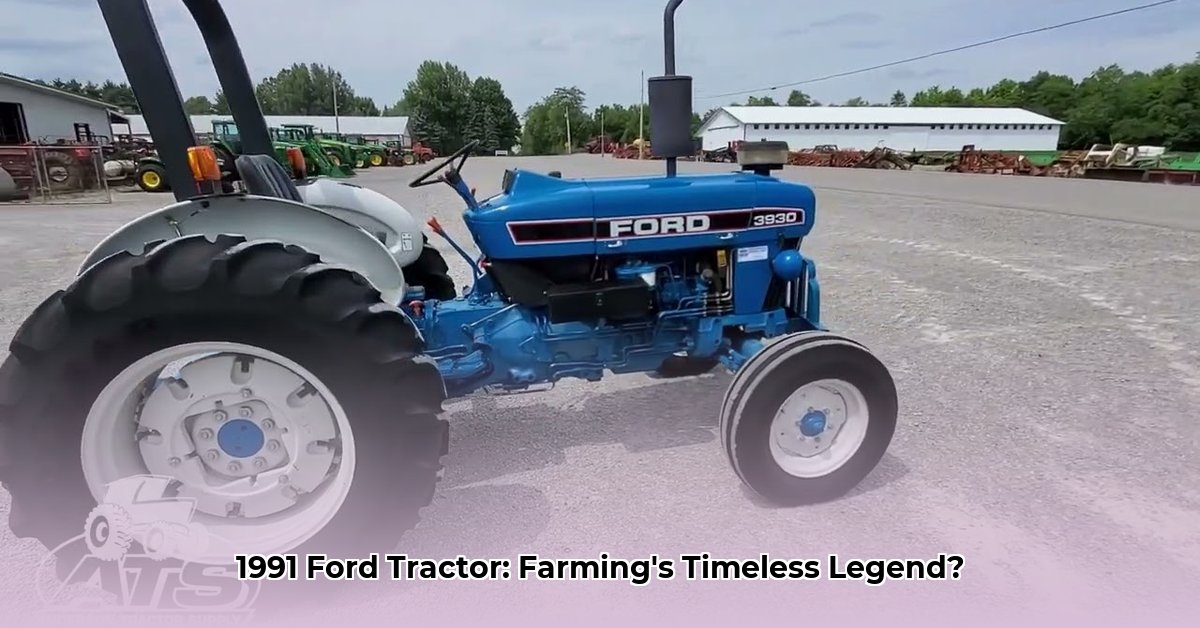
That familiar rumble of a Ford tractor—a sound synonymous with generations of farmers. But in our increasingly eco-conscious world, where does a 1991 Ford tractor fit into the narrative of sustainable agriculture? This isn't just a story about a vintage machine; it's a journey into the history of farming, the challenges of maintaining older equipment, and how those choices impact the future of sustainable agriculture. We'll explore how Ford tractors revolutionized farming, offer practical advice on keeping your 1991 model running smoothly, and examine the broader environmental implications of our choices regarding farm machinery. For more on Ford tractor canopies, check out this resource.
A Legacy in the Fields: The Enduring Impact of Ford Tractors
The name "Ford tractor" itself conjures images of sun-drenched fields, hardworking farmers, and unwavering progress. From the revolutionary Fordson, a true game-changer in its time, to subsequent models, Ford's influence on agriculture is undeniable. These weren't merely tools; they represented advancements, allowing farmers to cultivate larger areas with increased efficiency. The straightforward designs of early models often simplified repairs—a significant advantage in eras before readily available specialized mechanics. Their legendary durability, passed down through families, created a reputation for reliability and longevity that continues to resonate today. However, the agricultural world, like all aspects of life, is constantly evolving.
The 1991 Ford Tractor: Durability and Sustainability in Focus
Detailed information on the fuel efficiency and emission data for a specific 1991 Ford tractor model is unfortunately scarce. Official records from that period are not always easily accessible. However, we can still draw valuable insights. The remarkable resilience of these older Ford tractors is frequently praised by owners and operators. Many are still in operation, a testament to their robust construction. This inherent longevity is a key element of their sustainability story—reducing the need for frequent replacements directly contributes to a smaller environmental footprint. However, this endurance also introduces its own challenges.
The Two Sides of Maintaining a Vintage Farm Machine
Repairing a 1991 Ford tractor differs significantly from maintaining modern tractors. Sourcing parts can be a considerable hurdle, demanding ingenuity and resourcefulness from mechanics. This highlights a crucial paradox of sustainability. While extending a machine's lifespan is environmentally beneficial, the difficulty in obtaining parts can somewhat offset these gains. Is maintaining an older machine truly sustainable? The answer is multifaceted and depends on several factors. Sustainable farming demands a long-term perspective. While newer tractors might boast better fuel efficiency and lower emissions, their shorter lifecycles and higher initial costs can diminish those benefits over the long run. A farmer may replace a modern tractor multiple times during the operational lifespan of a well-maintained older Ford.
Choosing Wisely: A Comparative Look at Old and New Tractors in Sustainable Farming
The decision between a vintage tractor like the 1991 Ford and a contemporary, eco-friendlier machine depends on the farmer's financial situation, farming practices, and comfort level with repairs. There's no universal solution. But the conversation shouldn't focus solely on the choice between old and new. A broader discussion encompassing the full lifecycle of farm equipment is crucial. This includes careful consideration of manufacturing, transportation, usage, repair, and eventual disposal. We need a more holistic approach.
The Role of Manufacturers, Policymakers, and the Future of Sustainable Agriculture
Responsibility doesn't rest solely with the farmer. Manufacturers should prioritize designing easily repairable and maintainable machines using readily available, durable parts. Policies that support repairs and discourage unnecessary replacements can significantly reduce the environmental impact of farming. The 1991 Ford tractor provides a powerful case study. Sustainable agriculture isn't just about the machine itself; it encompasses the entire system. This includes readily available and accessible repairs, a focus on extending the life of existing machinery, and a comprehensive approach to agricultural technology. The path to a truly sustainable future in agriculture requires innovative solutions which balance efficiency with environmental responsibility. It's an ongoing journey demanding continuous innovation and adaptation.
Practical Steps for Sustainable Tractor Maintenance
Here are actionable steps to maximize your older tractor's lifespan and sustainability:
Prioritize Preventative Maintenance: Regular maintenance is paramount. Addressing minor issues promptly prevents major breakdowns, extending your tractor's operational life significantly.
Cultivate Relationships with Experienced Mechanics: Connect with mechanics specializing in older tractors. Their expertise is invaluable in sourcing parts and performing efficient repairs.
Explore Alternative Parts Sourcing: Consider repurposing parts, employing substitutes, or even exploring 3D printing for unavailable components.
The 1991 Ford tractor serves as a compelling symbol. Sustainable farming considers the entire system. It's about accessible repairs, readily available parts, and a thoughtful approach to agricultural technology. The journey toward a truly sustainable future in agriculture requires innovative solutions that balance efficiency and environmental stewardship. It's a continuous journey, and the conversation is just beginning.